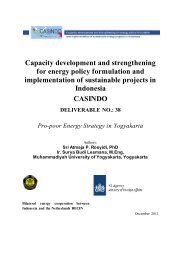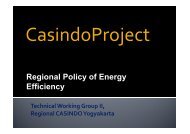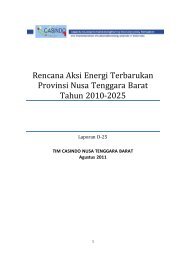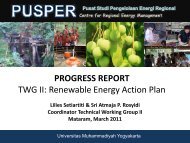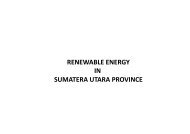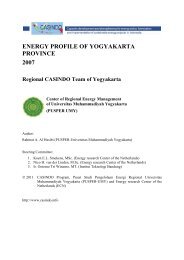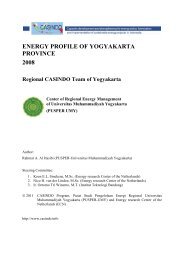CASINDO UNDIP
CASINDO UNDIP
CASINDO UNDIP
You also want an ePaper? Increase the reach of your titles
YUMPU automatically turns print PDFs into web optimized ePapers that Google loves.
<strong>UNDIP</strong> TEAMTECHNICAL WORKING GROUP III :Energy Efficiency Master Plan
The energy demands of Central Java are projectedusing the LEAP software with a scenario of theRegional Energy Policy, which is based on data2005 – 2008, note that until the year 2025 showedan increase It is estimated that energy demand until the year2025, could not be fully supplied so that energyefficiency need to be done, involvinggovernments, energy users and equipment, aswell as manufacturers of energy efficientequipment
Sector2005(%)2007(%)2009(%)2010(%)2015(%)2020(%)2025(%)Transportation 39.92 41.67 42.73 42.99 42.50 40.75 38.06Industry 20.73 20.10 19.82 19.80 20.23 21.39 22.60Household 23.10 22.16 21.27 20.94 19.91 18.73 17.87Commercial 11.93 11.61 11.51 11.50 11.83 12.58 13.67Others 4.32 4.46 4.67 4.77 5.53 6.54 7.80
Energy Consumption Data 2006-2008Million SBMSector2006(mill SBM)2007(mill SBM)Household 10,85 12,06 13,26Industry 14,57 16,19 17,81Commercial 1,36 1,51 1,67222018161412102008(mill SBM)Transportation 12,74 14,15 15,57Others 1,68 1,87 2,06864202006 2007 2008HouseholdIndustryCommercialTransportationOthersThe target of EnergyEfficiency programme aresectors with most energyusage, which are:1. Industrial Sector2. Transportation3. Household Sector
Energy Source2006(million SBM)2007(million SBM)2008(million SBM)Coal (briquete) 0,018 0,020066 0,022073Biodiesel 0,076 0,085 0,093Avtur 0,66 0,73 0,803LPG 0,96 1,06 1,174949Fuel Oil (minyak bakar) 1,55 1,727233 1,899958Firewood 1,58 1,751682 1,92685Electricity 6,15 6,83 7,52Kerosene 6,26 6,957138 7,652851Solar 6,48 7,21 7,93Coal 7,87 8,740841 9,614926Premium 10,25 11,391178 12,530295
Million SBM121086420Coal Consumption20062007Million SBMConsumption 01412108642Premium ConsumptionConsumption20062007200810Kerosene Consumption0.1Biodiesel ConsumptionMillion SBM8642200620072008Million SBM0.080.060.040.022006200720080Consumption0Consumption
Million SBMMillion SBM21010.50Fuel Oil Consumption200620072008Million SBMConsumption0ConsumptionBiosolar Consumption108200662007200842ConsumptionAvtur ConsumptionElectricity Consumption200620072008Million SBM1050Consumption200620072008
1.5LPG Consumption3Firewood ConsumptionMillion SBM10.5200620072008Million SBM212006200720080Consumption00.03Coal Briquette ConsumptionConsumptionMillion SBM0.020.012006200720080Consumption
Million SBMIndustry Consumption2015200620071020085Million SBM21.510.5CommercialConsumption200620072008Million SBM15105HouseholdConsumption2006200720080Consumption0Consumption 0ConsumptionTransportationConsumptionOther SectorConsumptionMillion SBM2015105200620072008Million SBM2.521.510.52006200720080Consumption0Consumption
To realize energy efficiency in household,industry, and transportation throughspecified, realistic, and sistematic steps.
Industrial and Workers Data for Central Java
NOGOAL ANDPOLICYINSTRUMENTAwareness and1 Education energyPROGRAMME HOUSEHOLD COMMERCIAL INDUSTRY TRANSPORTATION PUBLICSECTOR1. Campaign - Placement ofefficiency ratein the electricityand fuel usage- SNIImplementation- Energyconservationand Efficiencyin the buildingplanning andoperation-Availability ofbooks andbrochuresabouttechnologyand thesuccess ofenergyefficiencyandconservation- Availability of booksand brochuresabout energyconservation andefficiency, thesuccess of energyefficiency andconservationImplementationof Demand SideManagement(DMD)Availability ofinformationabout DSMprogrammeTheexistence ofenergyconsumption initiative
NOGOAL ANDPOLICYINSTRUMENTPROGRAMME HOUSEHOLD COMMERCIAL INDUSTRY TRANSPORTATION PUBLICSECTOR4. Pilot project Energyefficienthousing (greenhouse)Modelling5. Dialog Etablishment offorum6. Multi-sectorprogrammeConservationand energyefficiencyforumSufficientinformationabout energyefficientequipment(low-loss,electronicballast, VSD,high efficiencymotor, LHE,etc)Energy-efficienthousing (greenhouse) ModellingEtabhlishmentof Conservationand energyefficiency forumSufficientinformationabout energyefficientequipment(low-loss,electronicballast, VSD,high efficiencymotor, LHE, etc)Improvementin applicationof energyefficienttechnologyEtabhlishment ofConservationand energyefficiencyforumSufficientinformationabout energyefficientequipment(low-loss,electronicballast, VSD,highefficiencymotor, LHE,etc)Improvement inapplication ofenergy efficienttechnologyEtabhlishment ofConservation andenergy efficiencyforumImprovementin applicationof energyefficienttechnologyEtabhlishmentofConservationand energyefficiencyforumSufficientinformationabout energyefficientequipment(low-loss,electronicballast, VSD,high efficiencymotor, LHE,etc)
NO GOAL AND POLICYINSTRUMENT2 Controllinginstrument isintended to fastenenergy eficiencyprgrammePROGRAMME HOUSEHOLD COMMERCIAL INDUSTRY TRANSPORTATION PUBLICSECTOR7. Energy audit Free energyauditprogramme,Availability ofenergy servicecompany (ESCO)8. EnergyManagement9. EnergyefficientEquipmentEfficiencyenhancementin energyusageReplacementof unefficientenergy usageperipheralAssignment ofenergyadministratorThe existence ofeducationinstitution andenergyadministratorcertificationEfficiencyenhancement inenergy usageReplacement ofunefficientenergy usageperipheralFree energyauditprogramme,Availability ofenergy servicecompany(ESCO)Assignment ofenergyadministratorThe existenceof educationinstitution andenergyadministratorcertificationEfficiencyenhancementin energyusageReplacementof unefficientenergy usageperipheralFree energy auditprogramme,Availability ofenergy servicecompany (ESCO)Efficiencyenhancement inenergy usageReplacement ofunefficient energyusage peripheralFree energyauditprogramme,Availability ofenergy servicecompany(ESCO)Efficiencyenhancement in energyusageReplacementof unefficientenergy usageperipheral
NO GOAL AND POLICYINSTRUMENT2 Controllinginstrument isintended to fastenenergy eficiencyprogrammerealization andcreate a condusiveclimate for energyefficiency realizationPROGRAMME HOUSEHOLD COMMERCIAL INDUSTRY TRANSPORTATION PUBLICSECTOR10. Labelisation Theimplementation of energyefficiencylabel inhouseholdperipheral11.Standardization12. PromotioninitiativeInitiative ofcommunity topromoteenergyeffienctproductSocialization ofenergyconservationstandardimplementation in buildingsMinimumenergyefficiency to bea policyTechnologyprocurementimplementationEnergyefficientproductpromotionImplementation of energyefficientlabellingAvailability ofproducttester agencyand approvedcertificationagencyMinimumenergyefficiency tobe a policyTechnologyprocurementimplementationEnergyefficientproductpromotionMinimum energyefficiency to be apolicyTechnologyprocurementimplementationEnergy efficientproduct promotionImplementation ofenergyefficiencystandardMinimumenergyefficiency tobe a policyTechnologyprocurementimplementationEnergyefficientproductpromotion
NOGOAL ANDPOLICYINSTRUMENT3 Insentives 13. FiscalinsentivePROGRAMME HOUSEHOLD COMMERCIAL INDUSTRY TRANSPORTATION PUBLICSECTOR14. SubsidyDiversion15.RewardThe use ofrevenue to buycertain energyefficientperipheralThe awardingin certaineventsImplementationof easierinvestationthrough BOT,joint ventureand projectfinancing withfinancialinstitutionThe use ofrevenue to buycertain energyefficientperipheralThe awarding incertain eventsImplementationof easierinvestationthrough BOT,joint ventureand projectfinancing withfinancialinstitutionThe use ofrevenue to buycertain energyefficientperipheralThe awarding incertain eventsThe use of revenueto buy certain energyefficient peripheralThe awarding incertain eventsAvailability ofconservationenergy projectfinancialplatform
No Policy Programme1 Awarenessand Education2 Controlling3 Insentif4Markettransformation1. Campaign- EE labelling- Energi efficiency sign2. Training3. Education4. Pilot project5. Dialog Forum6. Multi sector7. Energy audit8. Energy Management9. EE-Technology10. EE Label ling11. Standardization12. Procurement Initiative13. Fiscal Insentive14. Subsidy diversion15. Appreciation16. Partnership17. Procurement InitiativeIMPLEMENTATION STEPDomestic Commercial Industry Transportation OthersNotes: 1. Urgent2. Necessary3. Usual
Culture Background [ for Household ] Paternalistik culture ( is a culture which thecommunity member will always accept the statementfrom their leader, in Javanese language is calledSendiko Dawuh ) [+] Central Java community having a very intensesociality [+] Narimo ing pandum, is a culture which every javanesewill always be very grateful for everything they had[+] [-] Central Java has many Universities, each have goodcorrelation to community around them, through theirsocial responsibility programmes [+]
CREATING PUBLIC AWARENESSEnergy Saving PotentialFor Turn Off 1 Lamp 1 Household On Peak LoadEnergy Saving PotentialEnergy saving per household for 5hours (17.00 pm-22.00 pm)Energy saving for all household ( 1million households)*Scenario Power of Lamp8 Watt 12 Watt40 Wh 60 Wh400 MWh 600 MWhFinancial Saving for all household (in IDR )*) 1 kWh = IDR 500,-IDR 200 Million / dayIDR 300 Million / day
Case studies Result in PT Primayuda Mandirijaya – Boyolali Regency – Central JavaSector/Briefdescription-Textile andPaper industry-Producesvarious kind ofcotton threadballMain energydemandElectrical energyto operatevarious kind ofproductionmachinesswhich are drawnfrom PT.PLN.Current energytypeHas convert theMFO for watersteam boilerwith more costefficientcoalInvestigatedenergyalternatives-Thetransformatorcapacity factorand load factorare already atefficient rate-The loadapplied to eachdieselgenerator isn’tsame. It’sbecause eachproduction linehas differentamount of loadfrom theirmeachines.Energymanagement-Use of energymanagementmatrix as thechoosenapproach bythe company-Theformulation ofSOP (StandardOperationProcedure) inenergy usageto simplify theirimplementation-Provide bestpracticeworkshops foreach department.Follow upactivities-Therearrangementof panels(regrouping)based on theproductionmachines.-Updatingenergymanagementsystem basedon theregroupingresult- Procurementof coal energytester
ELECTRICAL OPERATIONAL COST REVIEWMonthKWH(LBWP)KWH(WBP)KVARTOTALkWhTotal CostRpJanuary 1.800.000 136.000 0 1.936.000 954.043.600February 1.736.000 152.000 0 1.888.000 942.293.665March 2.088.000 168.000 0 2.256.000 1.125.174.760April 2.200.000 160.000 0 2.360.000 1.144.606.260MeyJuneJulyAugustSeptemberOctobreNovemberDecemberTotal
ANNUAL PRODUCTION REVIEWMONTHPRODUCTION IN 2010 (Kg)SPG-1 SPG-2 SPG-3TOTALINDICATOR OFCONCUMPTIONENERGYJanuary 696187 483357 1995.85 1181540 1.639February 523637 565368 0 1085376 1.739March 755155 756425 36650 1548231 1.457April 698001 707617 59875 1465494 1.610MeyJuneJulyAugustSeptemberOctoberNovemberDecemberJumlah
PRODUCTION MACHINES AUDITNoUnitInstalledPower(NamePlate)(kW)PhaseVoltage(V)Current(Actual)(A)PF(Cos phi)EstimatedOperatingTime(hours/day)ActualPower(Calculation)Blowing 3 380 11,1Uniclean 3 380 17,2Unimix 3 380 1,13 380 0,93 380 0,83 380 0,8Uniplex 3 380 8,5
PLN SUPPLY QUALITY CHECKNo.Item1 Load (kW)2 Voltage (V)3 Freqwency (Hz)4 Load(KVAR)Data aquisition time00.00 04.00 08.00 12.00 16.00 18.00ITEM TRAFO A TRAFO B TRAFO C TRAFO DPower Factor 1 1 1 1KW 1350 1400 1700 1600KA 1,4 1,2 2,45 2,5
DAILY LOAD FLUCTUATION CHECK FOR PLN SUPPLYDate PLN Boyolali PLN Salatiga PLN Sumur Total1 70320 62360 128 1328082 70560 61240 160 1319603 66000 54920 136 1210564 51200 48560 160 999205 47920 37160 104 851846 75200 66880 104 1421847891011121314151617181920
SELF GENERATED SUPPLY POWER QUALITY CHECK(Voltage and Frequency)No.ItemLoad (kW)Voltage (V) Voltage (V)Freqwency (Hz)Load (KVAR)Data Aquisition Time00.00 04.00 08.00 12.00 16.00 18.00
SELF-GENERATED SUPPLY DAILY FLUCTUATION CHECKTime 00.00 00.30 01.00 01.30 02.00 02.30 03.00 03.30Load(kW)Time 04.00 04.30 05.00 05.30 06.00 06.30 07.00 07.30Load(kW)Time 08.00 08.30 09.00 09.30 10.00 10.30 11.00 11.30Load(kW)Time 12.00 12.30 13.00 13.30 14.00 14.30 15.00 15.30Load(kW)Time 16.00 16.30 17.00 17.30 18.00 18.30 19.00 19.30Load(kW)Time 20.00 20.30 21.00 21.30 22.00 22.30 23.00 23.30Load(kW)
THERMAL AUDITBOILER SPECIFICATION1. Boiler Maker & Year COALMAX – 2004 – India2. MCR (MAX. Continuous Rate) 10.000kg/day3. Type of Boiler CX100/104. Fuel Fired CoalBOILER SYSTEM SCHEME
TYPE OF FUELBoiler No.FuelVelocity(m 3 /h)Temp(°C)Pressure(kg/cm 2 )NotesEXHAUST GAS CONDITIONBoiler No.Velocity(m 3 /h)Temp(°C)SmokeNo.Room Temp
BOILER FILLER WATER CONDITIONTemperature (°C)VelocityPressureBoiler No.Before After(m 3 /h)(kg/cm 2 )economizer Economizer1. 180 60 5TDSNotesCOMBUSTION AIR CONDITIONBoiler No.Velocity(m 3 /h)1. 142Temperature (°C)Ambient Wet bulb Dry BulbBeforeHeaterAfterHeaterNotes
BLOWDOWN AIR CONDITIONBoiler No.Velocity(m 3 /h)Temperature(°C)TDSNotesBOILER WALL CONDITIONBoiler No.Temperature(°C)Surface Area(m 2 )Notes
STEAM CONDITIONBoiler NoVelocity(m 3 /h)Temperature(°C)Pressure(kg/cm 2 )Steam QualityNotes1. 7,5FUEL AND WATER USAGEMonth Coal (kg) Air (m 3 )January 79,427 377February 66,746 351March 85,537 383April 94,051 392May 111,467 395June 73,393 400July 83,837 437August 84,839 380
2. STEAM DISTRIBUTION SYSTEMSTEAM DISTRIBUTION FLOWCHARTPIPING AND PI&D SCHEMATIC
3. INSULATIONINSULATION CONDITION1. Insulator Material Alumunium Foil Coated- Asbes2. Insulator Thickness 20 mm4. PUMPPUMP SPECIFICATION1.` Pump Maker & Year2. Rated Flow Rate3. Type of Pump4. Type of Drive5. Power Consumption6. Motor Efficiency7. Suction Head8. Total Head
PUMP SYSTEM SCHEMEMEASUREMENT DATAPump NoVelocity(m 3 /h)SuctionHead (m)DischargeHead (m)Total Head(m)ActualPowerConsumption (kW)Density ofthe Fluid(kg/m 3 )Notes
5. HEAT EXCHANGER (HE)HEAT EXCHANGER SPECIFICATION1 HE Maker & Year2 Heat Duty (kW)3 Tube Side4 Nozzle quantity, OD, thickness(mm), length (mm)5 Type of Pitch, length6 Pass Quantity7 Shell Side8 External Diameter9 Baffle Space10 Pass Quantity1112 Parameters Inlet Outlet13 Hot fluid flow, W (kg/h)14 Cold fluid flow, W (kg/h)15 Hot Fluid Temp (°C)16 Cold Fluid Temp (°C)17 Hot Fluid Pressure, P (bar g)18 Cold Fluid Pressure, P (bar g)
HEAT EXCHANGER SYSTEM SCHEMEMEASUREMENT DATAParameters Inlet OutletHot fluid flow, W (kg/h)Cold fluid flow, W (kg/h)Hot Fluid Temp (°C)Cold Fluid Temp (°C)Hot Fluid Pressure, P (bar g)Cold Fluid Pressure, P (bar g)
PHYSICAL PROPERTIES DATAParameters Units Inlet OutletHot fluid density Kg/m 3Cold fluid density Kg/m 3Hot fluid ViscosityMpaSCold fluid ViscosityMpaSHot fluid ThermalkW/(m.K)ConductivityCold fluid Thermal kW/(m.K)ConductivityHot fluid Heat Capacity kJ/(kg.K)Cold fluid Heat CapacitykJ/(kg.K)
CALCULATION DATAParameters Units Test Data Design DataHeat DutykWHot fluid side pressure drop BarCold fluid side pressure dropBarTemperature Range hot fluid °CTemperature range cold fluid °CCapacity RatioEffectivenessCorrected LMTD, MTD °CHeat Transfer Coefficient kW/(m.K)
ENERGY MANAGEMENT RECOMMENDATION1Energy EfficiencyactionElectricalenergyconsumptionkWh/yrRp/yrThermalEnergyConsumptionLitre/yrRp/yrEnergy EfficiencyPotentialkWh/yr%kWhRp/yr % NocostImplementationCostMiddlecostHighcostPBP(yrs)WillbeFS23Total
ENERGY EFFICIENCY MANAGEMENT MATRIKSLEVEL4POLICY ORGANISASI SISTEM KOMUNIKASI PENGAWASAN/PELAPORANThere already a personresponsible in energyconsumption supervisionEnergy user’s commitment toEnergy Efficiency ManagementSystem which covered WorkPlan Policy and monitoringEnergy user and others relatedto already use an integratedcommunication system inenergy consumption controlDetermining target,supervising energyconsumption, handlingproblems, evaluate theefficiency and energy costAWARENESSSocialization about theneed of energy efficiencyto every energy user andrelated people.INVESTASIAll investation alreadyenergy efficiencyoriented3There already energymanagement policy, but there’sno commitment from the leaderof energy usersEnergy user is responsible toall energy consumptioncommunication operator forenergy consumption andmonitoring.The report about energyconsumption and supervision,which not all of them basedon measurement, and withoutfeedback to energy users.Training procedure,general awarenesssocialization, using theregular criteria ofusabilityThe exact measurementof every building,peripheral, and thechance to increase theenergy effiency2There are a Energymanagement policy fromenergy users, but it hasn’tbecome a global policyThere are energy users withuncertain support andassignment, and the receiverof energy management reportThere’s a communication withanother energy users, based oncoordinationEnergy efficiencyachievement and monitoringreport only based onaccounting data, without anyfeedback to energy users.There already budgetalloocation, and theawareness, workshopsalready been clarifiedOnly energy investationwith short paybackperiod which is plannedand executed1Energy management andunwritten policy as a part ofauthority which is limited andnot too determiningThe existence of informalcommunication andunsysthemic between theenergy users and some ofother energy users.There are the report of energyusage cost.Energy users make aefficiency report on energyusage, only for their workingscopeThere’s an informalcommunication andunsysthematic to increaseenergy efficiencyOnly without cost danlow cost repair whichare implemented forenergy efficiency0There’s no good energymanagement policy fromenergy users, planner, orresponsible personThere’s no communicationbetween energy usersThere’s no communication orreport about energyThere’s no report of energyusageThere’s no socializationabout energy efficiencyThere’s no investationabout energy efficiency
Next Audit Activities Industrial : 2 industrial ( Medium and small ) Government building : Pem.Prov. Jawa Tengah,<strong>UNDIP</strong> and KARYADI Hospital Household : Big, medium and small City ( lower,middle and upper class income ) Public : Street Lighting Transportation : Public and Private Transportation (only evaluation policy ) Data Collecting Data Analysis
1 ST WORKSHOP <strong>CASINDO</strong>PROJECT2 ND WORKSHOP <strong>CASINDO</strong>PROJECT
SOCIALIZATION OF <strong>CASINDO</strong>PROJECT Training Basic Leap



